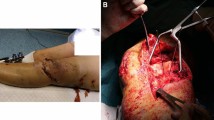Abstract
Introduction
Literature does not provide any reliable comparison between angular stable plate fixation and rigid nail fixation for stabilization of supracondylar periprosthetic femoral fractures. Thus, the purpose of this study was to compare these two implants in clinical practice relating to fracture healing, functional results and treatment-related complications.
Patients and methods
In this retrospective study (level IV), clinical and radiographic records of 86 patients (62 female and 24 male, average age: 75.6) with supracondylar periprosthetic femoral fractures between 1996 and 2010 were analyzed. 48 patients underwent lateral plate fixation by an angular stable plate system (LISS), whereas 38 patients were stabilized by a rigid interlocking nail device.
Results
Sixty-four (76 %) patients returned to their pre-injury activity level and were satisfied with their clinical outcome. We had an overall Oxford outcome score of 2.21, with patients following angular stable plate fixation of 2.22, and patients after rigid nail fixation of 2.20. Successful fracture healing within 6 months was achieved in 74 (88 %) patients. Comparing between plate fixation and nail fixation, statistical analysis did not reveal any significant differences.
Summary
Overall, we had a relatively high rate of fracture healing and a satisfactory functional outcome with both implants. Both methods of fixation showed similar results relating to the functional outcome and individual satisfaction of the patients. However, with regards to fracture healing and treatment-related complications, intramedullary nail fixation showed slight advantages.



Similar content being viewed by others
References
Kim KI, Egol KA, Hozack WJ et al (2006) Periprosthetic fractures after total knee arthroplasties. Clin Orthop Relat Res 446:167–175
Su ET, Hargovind D, Di Cesare P (2004) Periprosthetic femoral fractures above total knee replacements. J Am Acad Orthop Surg 12:12–20
Felix NA, Stuart MJ, Hanssen AD (1997) Periprosthetic fractures of the tibia associated with total knee arthroplasty. Clin Orthop Relat Res 345:113–124
Healy WL, Siliski JM, Incavo SJ (1993) Operative treatment of distal femoral fractures proximal to total knee replacements. J Bone Jt Surg Am 75:27–34
Inglis AE, Walker PS (1991) Revision of failed knee replacements using fixed-axis hinges. J Bone Jt Surg Br 73:757–761
Ritter MA, Faris PM, Keating EM (1988) Anterior femoral notching and ipsilateral supracondylar femur fractures in total knee arthroplasty. J Arthroplasty 3:185–187
Kolb K, Koller H, Lorenz I, Holz U, Marx F, Grützner P, Kolb W (2009) Operative treatment of distal femoral fractures above total knee arthroplasty with the indirect reduction technique. A long-term follow-up study. Injury 40:433–439
Koval KJ, Hoehl JJ, Kummer FJ et al (1997) Distal femoral fixation: a biomechanical comparison of the standard condylar buttress plate, a locked buttress plate, and the 95-degree blade plate. J Orthop Trauma 11:521–524
McLaren AC, Dupont JA, Schroeber DC (1994) Open reduction internal fixation of supracondylar fractures above total knee arthroplasties using the intramedullary supracondylar rod. Clin Orthop Relat Res 302:194–198
Murrel GA, Nunley JA (1995) Interlocked supracondylar intramedullary nails for supracondylar fractures after total knee arthroplasty. A new treatment method. J Arthroplasty 10:37–42
O’Tool RV, Gobezie R, Hwang R et al (2006) Low complication rate of LISS for femur fractures adjacent to stable hip or knee arthroplasty. Clin Orthop Rel Res 450:203–210
Althausen PL, Lee MA, Finkemeier CG et al (2003) Operative stabilization of supracondylar femur fractures above a total knee arthroplasty. A comparison of four treatment methods. J Arthroplasty 38:834–839
Chakravarthy J, Bansal R, Cooper J (2007) Locking plate osteosynthesis for Vancouver type B1 and type C periprosthetic fractures of the femur: a report on 12 patients. Injury 38:725–733
Fulkerson E, Koval K, Preston CF et al (2006) Fixation of periprosthetic femoral shaft fractures associated with cemented femoral stems: a biomechanical comparison of locked plating and conventional cable plates. J Orthop Trauma 20:89–93
Perren SM (2002) Evolution of the internal fixation of long bone fractures. The scientific basis of biological internal fixation: choosing a new balance between stability and biology. J Bone Jt Surg Br 84:1093–1110
Sah AP, Marshall A, Virkus WV et al (2010) Interprosthetic fractures of the femur. J Arthroplasty 25:280–286
Author information
Authors and Affiliations
Corresponding author
Rights and permissions
About this article
Cite this article
Aldrian, S., Schuster, R., Haas, N. et al. Fixation of supracondylar femoral fractures following total knee arthroplasty: is there any difference comparing angular stable plate fixation versus rigid interlocking nail fixation?. Arch Orthop Trauma Surg 133, 921–927 (2013). https://doi.org/10.1007/s00402-013-1730-9
Received:
Published:
Issue Date:
DOI: https://doi.org/10.1007/s00402-013-1730-9




